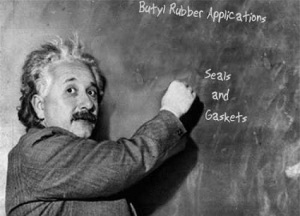
Learn about the properties of butyl rubbers and the applications for butyl rubber seals and gaskets.
Doug Sharpe
President of Elasto Proxy
Did you drive to work today? Maybe you took the bus instead. If your commute involved traveling on tires, then butyl rubber helped get you there. Tires are made of several different elastomers, but butyl plays a special role. Because this synthetic rubber resists the passage of gases, butyl is used for the inner liner, the part of the tire that holds the compressed air. Butyl also resists moisture, and that helps keep the steel belts that are embedded in car, truck, and bus tires from rusting. Butyl resists chemicals, too.
Butyl Rubber Types
Do butyl’s properties make this synthetic elastomer a good choice for your sealing application? It depends. For starters, all butyl rubber is not the same. Isobutylene isoprene rubber (IIR) is used in the inner tubes for bicycle tires. Modern vehicle tires don’t have inner tubes, and use halogenated butyl rubber (halobutyl) in their inner liners instead. Halogenating butyl with either chlorine (chlorobutyl) or bromine (bromobutyl) enhances butyl’s properties, but may not be required for your application.
The characteristics of butyl rubbers can also be enhanced through of compounding ingredients and curing systems. Material buyers and product designers don’t need to be rubber chemists, but it’s important to understand that compound selection typically involves multiple considerations. For example, does your sealing application require gas and moisture resistance? Do you need gaskets that resist heat, ozone, and specific types of chemicals, too?
Let’s take a look at some applications for butyl rubber products. This can help you with compound selection, but it’s also important to work with a partner who listens to your needs and can recommend the right sealing solution.
Butyl Rubber Applications
Butyl rubber is used in cradle mounts for front-wheel drive automobiles, truck body mounts, bonded overload pads, and in elastic damper hang-straps. With its vibration damping, resistance to ozone, and heat aging properties, butyl is also used in automotive hoses and gaskets. Typically, chlorobutyl is used in steam and hot-water hoses. Chlorobutyl rubber compounds are also used in automotive seals and gaskets because of their resistance to attack under demanding environmental conditions.
Butyl rubbers aren’t just used in vehicles, however. In the building and construction industry, butyl is used alone or in combination with other elastomers to seal windows. In factories, foundries, and other facilities, halobutyl rubber products are used in conveying applications that require heat and chemical resistance. Often, these conveyor belts move hot materials or pass through industrial ovens or other high-temperature areas. The low permeability of halobutyl rubber compounds also makes them a good choice for tank linings that contact water, acids, or bases.
Finally, butyl elastomers are used widely in healthcare, pharmaceutical, laboratory, and other sanitary applications. For example, halobutyl rubbers are used in seals and stoppers because of their chemical resistance, biological inertness, and low permeability to air, gases, and moisture. Compared to standard butyl products, rubber stoppers made from bromobutyl have lower drug turbidity. Butyl rubbers are also used in gloves and in the condenser packing on electrical appliances.
Butyl Rubber Gaskets and Seals
Did this article help you with compound selection? Choosing the right elastomer for your sealing or gasketing application is important, but you’ll also want to pick a partner with custom fabrication experience and technical expertise. For over 25 years, Elasto Proxy has been solving sealing and insulation challenges in a wide variety of industries. How can we help you?
Contact Elasto Proxy for more information, look for us on LinkedIn, and enjoy this short video about butyl seals and gaskets.








